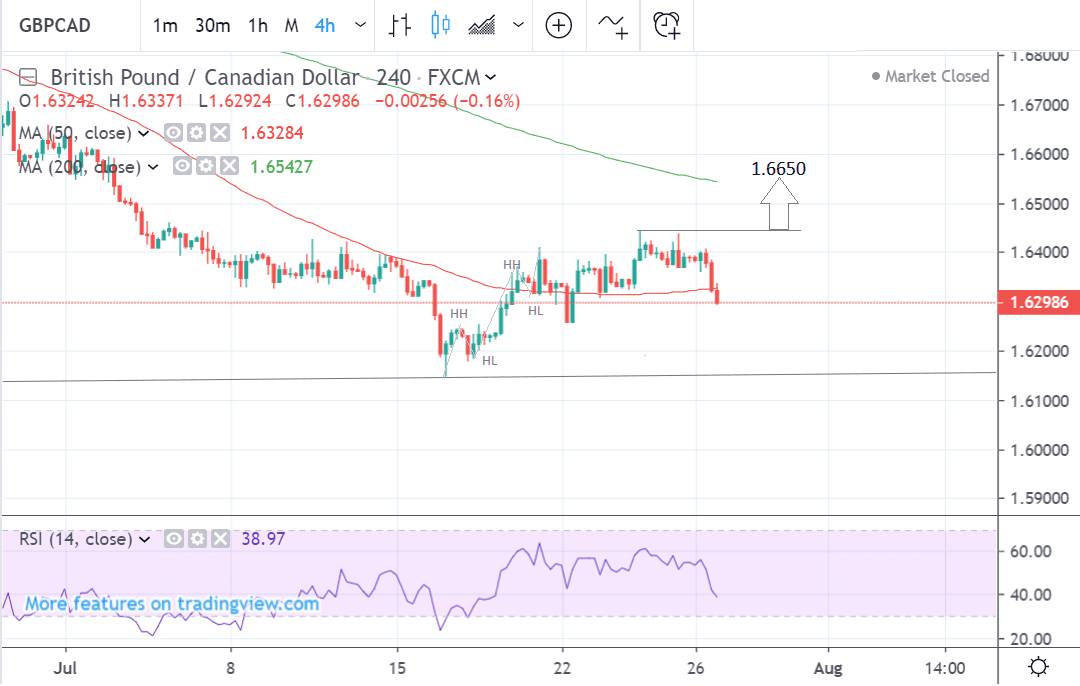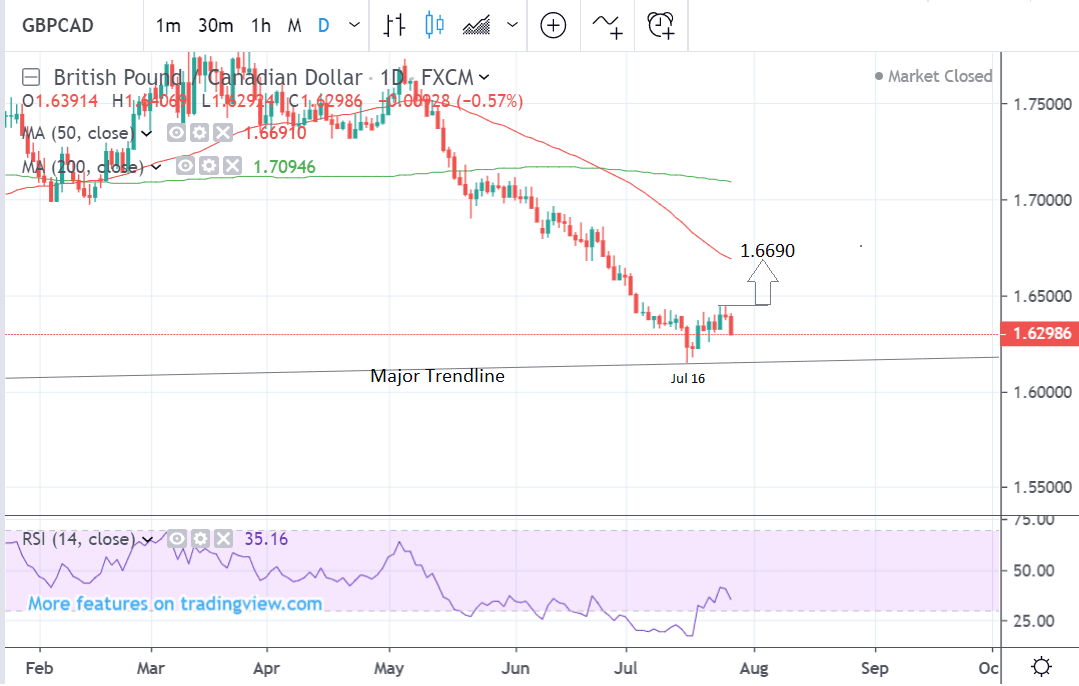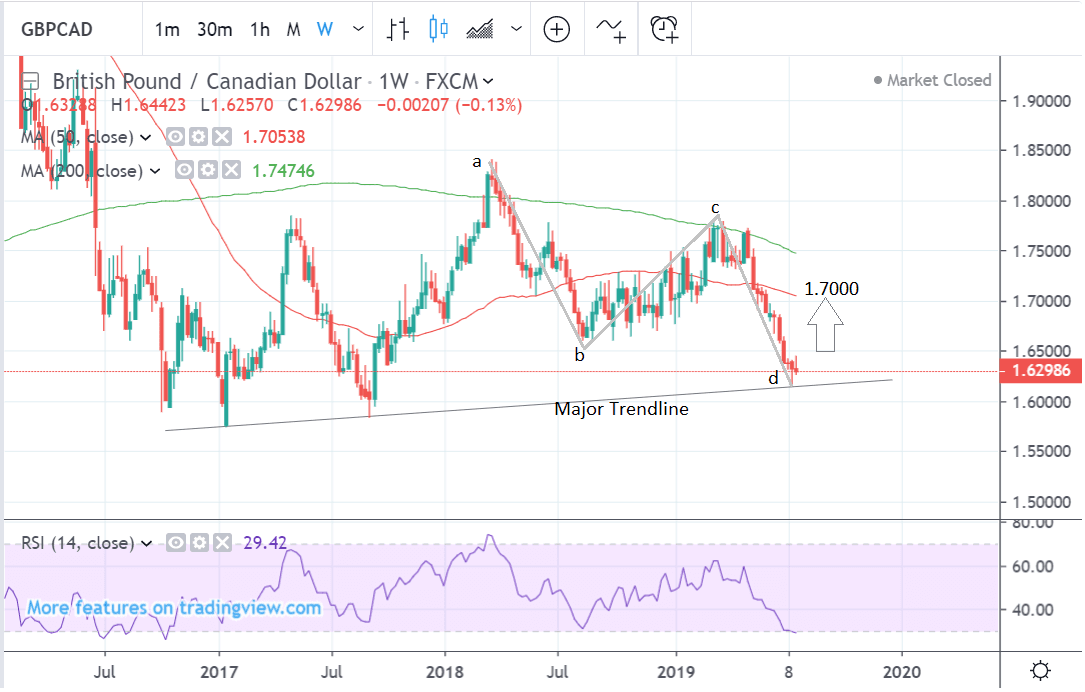Pound-to-Canadian Dollar Rate 5-Day Forecast: Bullish Reversal Possibile

Image © Pavel Ignatov, Adobe Stock
- GBP/CAD reversing and moving higher
- Break above highs could signal further upside
- Pound influenced by Brexit developments, PMIs and BoE meeting,
- Canadian Dollar to be driven by GDP
The GBP/CAD exchange rate is trading at around 1.6299 at the start of the new week, only 0.13% lower than a week ago.
Studies of the charts are showing further signs that the pair may have put in a bottom and be about to reverse trend and rise, although it is too early to say for sure and more upside would be conditional on the price rising above certain levels over the next few days.
The 4-hour chart - used to determine the short-term outlook, which includes the coming week or next 5 days - shows how the pair based on July 17 and then started rising. This new up-trend is likely to continue in the short-term subject to a break above the current highs.
The pair has already formed more than two sets of higher highs (HH) and higher lows (HL) which is a sign the trend may have changed.
The RSI momentum indicator was strong during the initial stages but now it has started to weaken after the pair rolled over at the July 24 highs and started falling. This is not a bullish sign but it doesn’t negate the bullish forecast bias.
A break above the 1.6442 highs would confirm the extension of the uptrend to a target at 1.6650.
The daily chart - used to give us an indication of the outlook for the medium-term, defined as the next week to a month ahead - shows the pair in an established downtrend with signs it may have bottomed at the recent July 16 lows.
The daily chart shows the same scenario playing out as in the 4hr chart, but with wider targets. A break to the upside would probably eventually reach the level of the 200-day moving average (MA) at 1.6690, where it would then be expected to encounter resistance.
The RSI momentum indicator is rising quite sharply and strongly, enhancing the bullish signal.
The weekly chart - used to give us an idea of the longer-term outlook, which includes the next few months - shows the pair forming a large ‘measured move’ price pattern, which it looks to have either finished or almost finished.
With measured moves the final C-D leg is usually of a similar length to the first A-B leg, suggesting an eventual downside target at around 1.6000.
The July 16 lows at 1.6145 were close enough to 1.6000 to potentially mark the end of the measured move. This is important because once the pattern is complete the next move is likely to be up.
Other bullish signs on the weekly chart are the hammer candlestick which formed the week before last, which is a bullish reversal pattern, and the fact the RSI momentum indicator has just entered the oversold zone, which suggests positioning may be stretched to the downside.
Time to move your money? Get 3-5% more currency than your bank would offer by using the services of foreign exchange specialists at RationalFX. A specialist broker can deliver you an exchange rate closer to the real market rate, thereby saving you substantial quantities of currency. Find out more here.
* Advertisement
The Canadian Dollar: What to Watch

The main driver of the Canadian Dollar in the week ahead is likely to be May GDP data out on Wednesday, although Chinese data could also impact due to its impact on global risk trends.
Canadian GDP is forecast to show a 0.1% rise on a monthly basis and 1.3% on a yearly basis in May when it is released at 13.30 on Wednesday. Such a result would be lower than April’s 0.3% and 1.5% respectively, however, assuming it does not undershoot, the Canadian Dollar should remain well supported.
It is still considered unlikely the Bank of Canada (BoC) will cut interest rates to stimulate growth, unlike the majority of central banks, so only a very poor result would question that assumption and see the Canadian Dollar weaken.
“On the whole, the data paints a picture of a relatively more vibrant Canadian economy. There is a strong chance that GDP growth for the second quarter comes in ahead of the Bank of Canada’s 2.3% forecast from earlier this month. Barring any unforeseen negative shocks, this should be enough to keep the Bank on the sidelines for the remainder of the year,” says Canadian investment bank TD Securities in a note previewing the data.
On the global front, Chinese PMI data will come into focus next week as July PMI data is released, and this will provide an insight into how the economy is coping with continued trade tensions. Recently Chinese manufacturing slumped into contractionary territory - below 50 - and if it falls any lower it could weigh on risk-sensitive assets such as the Canadian Dollar.
At the moment markets are actually expecting Chinese manufacturing to show a small rebound to 49.6 from 49.4 in June.
Anything greater could send the Canadian currency higher.
The Pound: Brexit Headlines, Bank of England

Brexit sentiment is easily the most important driver of the Pound at present, and weekend headlines are unsupportive of the currency we belief.
Media reports suggest Prime Minister Boris Johnson has fully committed to a 'no deal' Brexit "by any means necessary".
The Sunday Times reports Johnson has set up a “war cabinet” to deliver Brexit “by any means necessary” by October 31 as a senior cabinet minister warned that there was “now a very real prospect” of no deal.
While markets have ramped up expectations for a 'no deal' Brexit since May, it is likely that there is further 'no deal' risk sentiment to be absorbed and therefore Sterling has the propensity to move lower and trigger fresh multi-month lows.
"Though we still see the risk of a no-deal Brexit at a fairly moderate 20%, we are bearish on Sterling over the short-term amid the expectation that Mr Johnson’s rhetoric towards the EU will remain belligerent and perhaps harden further still in the run-up to 31 October," says George Brown, an analyst at Investec.
On the calendar, the main event for the Pound next week is the Bank of England (BOE) rate meeting, since the BOE sets interest rates which are tier 1 driver of the Pound, however, in reality this may not be the case. Brexit uncertainty has paralysed the BOE and until it is resolved they are highly unlikely to take any action and all their guidance will be conditional on ‘a smooth Brexit’.
"Another possible trigger for sterling could be next Thursday’s Bank of England MPC decision, which is set to be accompanied by the quarterly Inflation Report. Our expectation is that the committee will vote to maintain the Bank rate at 0.75% unanimously (9-0) for the eighth meeting in succession," says Brown.
The current stance is still marginally hawkish due to upbeat wage growth and this sets the BOE apart from most of its G10 peers, with the exception of the bank of Canada. This should translate into pent up upside potential for the Pound should the UK achieve a managed Brexit.
However, as anyone who has been following developments in the new Boris Johnson administration this is far from certain. Johnson has gathered what looks increasingly like a ‘war cabinet’ of Brexiteer ministers who might be prepared to take the UK out of the EU with a 'no deal' Brexit on October 31.
“The Bank of England continued to show a bias towards eventual tightening at its June meeting. This tightening is contingent on an eventual smooth exit from the European Union, however, an effort that has at times looked increasingly like a quixotic journey,” says Wells Fargo in a preview note on the meeting. “Inflation data have been stronger in the U.K. than in Europe, and according to the last statement “growth in unit wage costs has remained at target consistent levels.” “The U.K. economy has looked a bit more wobbly of late, particularly the manufacturing sector, which may be increasingly feeling the pressure from the factory sector struggles in continental Europe.”
The U.S. bank goes on to suggest ‘peer group pressure’ from other central banks turning increasingly dovish could be a further incentive for the BOE to turn dovish itself.
They forecast an eventual BOE rate hike not coming until 2020.
Given Manufacturing could be the weak link in the economy, the spot-light may be more closely trained on UK Manufacturing PMI data for July out on Thursday morning at 9.30 BST which is expected to show a decline to 47.7 from 48.0 previously.
A deeper-than-expected lapse as seen in European figures last week could spark weakness in the Pound, as it could be seen as the crack which could open up a wider slowdown.
Time to move your money? Get 3-5% more currency than your bank would offer by using the services of foreign exchange specialists at RationalFX. A specialist broker can deliver you an exchange rate closer to the real market rate, thereby saving you substantial quantities of currency. Find out more here.
* Advertisement







